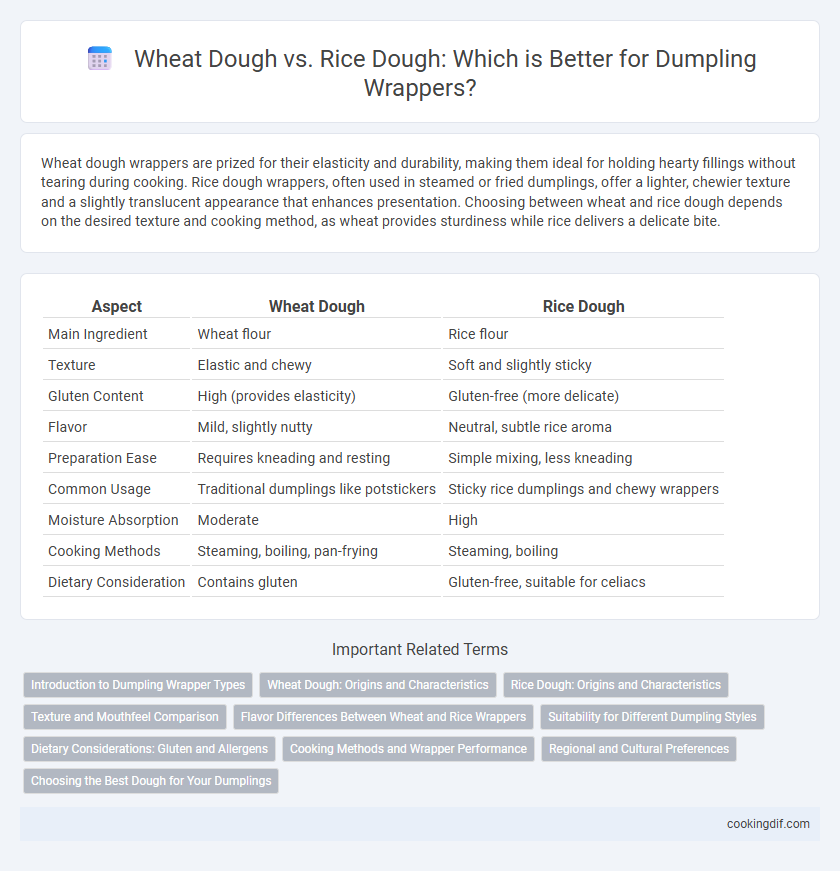Wheat dough wrappers are prized for their elasticity and durability, making them ideal for holding hearty fillings without tearing during cooking. Rice dough wrappers, often used in steamed or fried dumplings, offer a lighter, chewier texture and a slightly translucent appearance that enhances presentation. Choosing between wheat and rice dough depends on the desired texture and cooking method, as wheat provides sturdiness while rice delivers a delicate bite.
Table of Comparison
| Aspect | Wheat Dough | Rice Dough |
|---|---|---|
| Main Ingredient | Wheat flour | Rice flour |
| Texture | Elastic and chewy | Soft and slightly sticky |
| Gluten Content | High (provides elasticity) | Gluten-free (more delicate) |
| Flavor | Mild, slightly nutty | Neutral, subtle rice aroma |
| Preparation Ease | Requires kneading and resting | Simple mixing, less kneading |
| Common Usage | Traditional dumplings like potstickers | Sticky rice dumplings and chewy wrappers |
| Moisture Absorption | Moderate | High |
| Cooking Methods | Steaming, boiling, pan-frying | Steaming, boiling |
| Dietary Consideration | Contains gluten | Gluten-free, suitable for celiacs |
Introduction to Dumpling Wrapper Types
Dumpling wrappers primarily use wheat dough or rice dough, each offering distinct textures and culinary applications. Wheat dough wrappers, made from all-purpose flour and water, provide elasticity and a chewy bite ideal for boiled or pan-fried dumplings like potstickers and jiaozi. Rice dough wrappers, crafted from rice flour or a blend of rice and tapioca starch, create a translucent, delicate, and slightly sticky wrapper perfect for steamed varieties such as har gow or Vietnamese banh bot loc.
Wheat Dough: Origins and Characteristics
Wheat dough, originating from ancient China, serves as a staple wrapper ingredient in many dumpling varieties due to its elasticity and ability to hold fillings securely. Its gluten content creates a chewy texture that enhances the dumpling's structure and mouthfeel, differentiating it from rice dough which is typically softer and more delicate. Commonly used in potstickers and boiled dumplings, wheat dough offers versatility in cooking methods and pairs well with savory fillings like pork, vegetables, and seafood.
Rice Dough: Origins and Characteristics
Rice dough, traditionally used in Asian dumplings such as Vietnamese Banh Cuon and Chinese Chaozhou-style dim sum, originates from regions where rice cultivation is predominant. This dough, made from finely ground rice flour and water, offers a translucent, slightly chewy texture that distinguishes it from the denser wheat dough. Its gluten-free quality makes rice dough an essential ingredient for delicate wrappers that emphasize lightness and subtle flavors in dumpling recipes.
Texture and Mouthfeel Comparison
Wheat dough offers a chewy and elastic texture that holds fillings securely, providing a satisfying bite for dumpling wrappers. In contrast, rice dough tends to be softer and more delicate, yielding a tender mouthfeel with a slightly sticky surface that enhances smoothness. The choice between wheat and rice dough significantly influences the overall eating experience, balancing between firmness and melt-in-the-mouth softness.
Flavor Differences Between Wheat and Rice Wrappers
Wheat dough wrappers offer a chewy texture with a slightly nutty and wheaty flavor that complements savory fillings, enhancing the overall taste of dumplings. Rice dough wrappers provide a delicate, slightly sweet flavor and a soft, tender bite, creating a lighter contrast to rich fillings. The choice between wheat and rice wrappers significantly influences the dumpling's flavor profile and texture experience.
Suitability for Different Dumpling Styles
Wheat dough offers elasticity and strength, making it ideal for boiled or steamed dumplings like jiaozi and potstickers, which require a sturdy wrapper to hold fillings without breaking. Rice dough, softer and more delicate, suits translucent dumplings such as har gow, providing a chewy texture that complements lighter seafood or vegetable fillings. Choosing between wheat and rice dough depends on the desired dumpling style and texture, significantly impacting the final taste and presentation.
Dietary Considerations: Gluten and Allergens
Wheat dough for dumpling wrappers contains gluten, which can trigger allergies or sensitivities in individuals with celiac disease or gluten intolerance. Rice dough offers a gluten-free alternative, making it suitable for those with dietary restrictions related to gluten consumption. Choosing between wheat and rice dough depends on allergen sensitivity, with rice dough catering to a broader range of dietary needs.
Cooking Methods and Wrapper Performance
Wheat dough offers elasticity and strength, making it ideal for boiling, steaming, and pan-frying, as it holds fillings securely without tearing. Rice dough provides a delicate, gluten-free alternative, commonly used in steaming or boiling, resulting in a softer, chewier wrapper that absorbs flavors well but is more prone to breaking. The choice between wheat and rice dough influences cooking method effectiveness and the dumpling's texture, with wheat dough providing versatility and rice dough delivering a tender bite.
Regional and Cultural Preferences
Wheat dough is predominantly used in Northern Chinese dumplings due to its elasticity and ability to hold fillings firmly, reflecting the region's wheat cultivation and culinary traditions. In contrast, rice dough, often found in Southern Chinese and Southeast Asian dumplings like banh cuon or zongzi, showcases the abundance of rice and a preference for softer, chewier textures. These regional and cultural preferences highlight how staple crops influence dumpling wrapper ingredients, creating distinct culinary identities across Asia.
Choosing the Best Dough for Your Dumplings
Wheat dough offers elasticity and chewiness ideal for dumplings requiring a sturdy wrapper that holds fillings securely during steaming or boiling. Rice dough provides a gluten-free alternative with a delicate, slightly sticky texture suited for light, translucent dumplings like har gow or cheung fun. Selecting the best dough depends on desired texture, dietary needs, and cooking methods, with wheat dough favored for versatility and rice dough chosen for specialty gluten-free options.
Wheat Dough vs Rice Dough for wrapper ingredients Infographic

 cookingdif.com
cookingdif.com